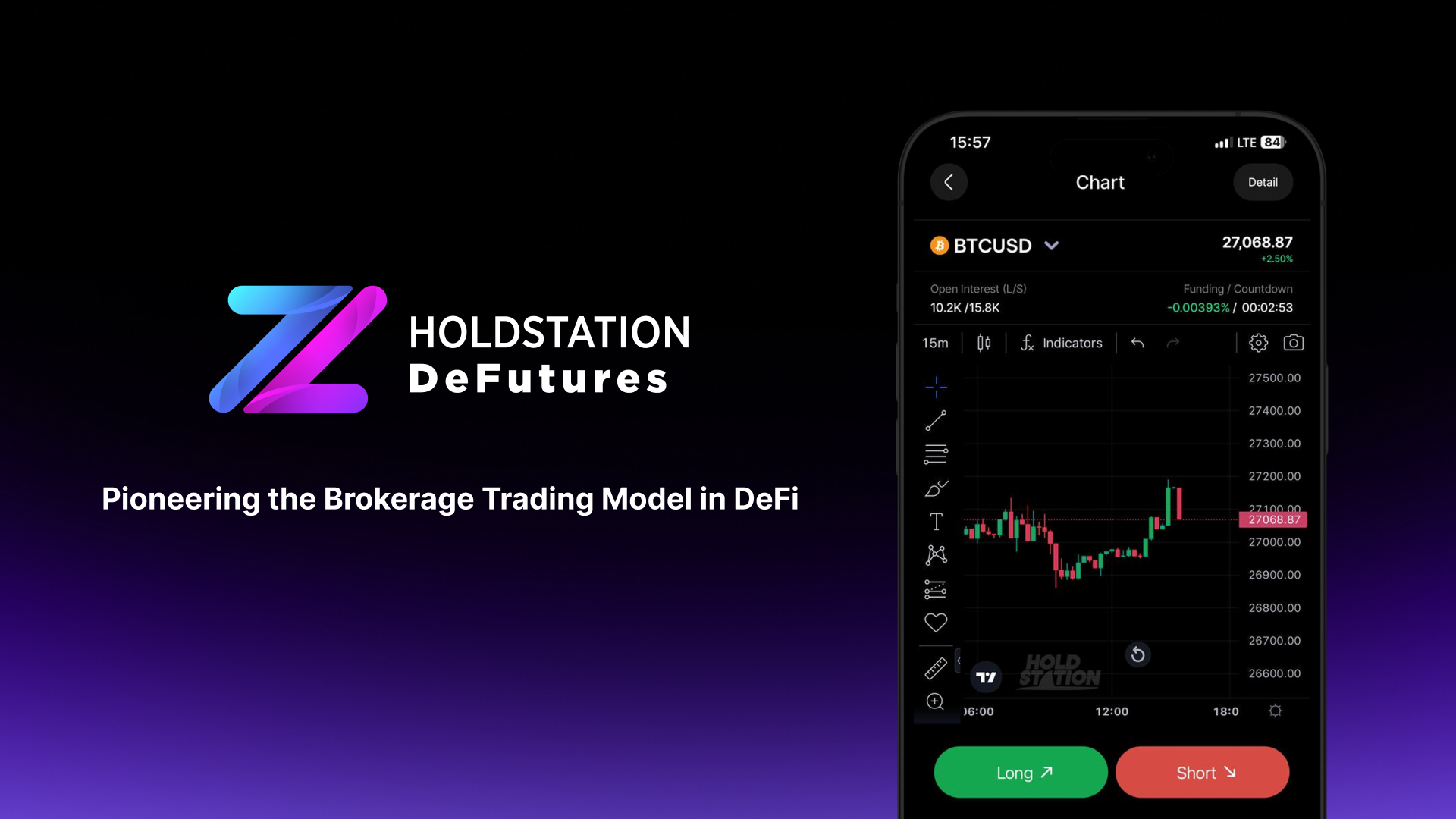Holdstation Defutures: Pioneering the Brokerage Trading Model in DeFi

Decentralized Exchanges (DEXs) currently, though promising, weren't the first choice for many serious traders due to issues like low liquidity, high slippage, and a lack of advanced order types. Thus, its journey hasn’t been smooth. After the exponential pump in TVL in the first half of 2022 with the bull market, DeFi now stands at $38,68b, seeing a 79% decrease from its peak at around $179b.
In this backdrop, Holdstation Defuture emerges as the beacon of hope. This entity seeks to address the pain points of both centralized and decentralized platforms, thus taking the trading experience for any user to a whole new level. But what sets Holdstation Defuture apart from traditional centralized trading platforms like MT4 and eToro in particular?
Centralization vs. Decentralization
While MT4 and eToro have made significant strides in the centralized trading world, they operate and manage users’ assets through a single entity. This centralization, although offering a streamlined user experience, often lacks the transparency and security inherent in decentralized systems.
Holdstation, on the other hand, operates on a decentralized model, leveraging blockchain technology to offer a transparent and trustless trading environment. It combines the best of both worlds, integrating decentralized features with the decentralized elements of blockchain.
Holdstation’s Brokerage Module: Empowering Brokers and Traders Alike
Holdstation goes beyond just being a perp DEX. With its front-end Software Development Kits (SDKs), it bridges traders to brokers and its own DeFutures Exchange. This positions DeFutures as a unique independent broker. The SDKs are equipped with pre-built functionalities, enabling developers to seamlessly integrate with APIs and smart contracts for data retrieval and trade execution.
However, Holdstation's responsibility is clear-cut: it oversees trades between traders and DeFutures and manages on-chain settlements. Trades involving other brokers on the Hyperliquid platform are outside its purview.
A standout feature is Holdstation's white-labeling process, inviting new brokers to join the Hyperliquid platform. This Brokerage module allows brokers to craft their own exchanges using Holdstation's robust technology. The ultimate aim? Expand Holdstation's user base through the broker network. Brokers are incentivized to compete, either by offering reduced fees or by setting their own bid-ask spreads.
The power lies with the traders, who choose their preferred counterparty. For brokers, the endgame is clear: cultivate a dedicated trader base and leverage market-making spreads or connect traders to DeFutures to earn commissions.
Holdstation Defutures: A Comprehensive Trading Platform
On top of having an impactful Brokerage Module, Holdstation Defutures stands out as a comprehensive platform for trading a wide range of assets, from cryptocurrencies to commodities like oil and gold. It supports EVM blockchains and integrates smart wallets, offering up to 500x leverage.

The architecture of DeFutures Exchange is layered into three main components:
- Pricing Layer: This layer ensures accurate asset pricing through the Dynamic Price Feed (DPF) algorithm. By gathering data from various sources, including centralized price oracles, the DPF minimizes inaccuracies and anomalies. In addition, The Flexible market-making model of Holdstation Defutures, inspired by DoDo's Proactive Market Making, uses oracle prices as a reference and linear price slippage.
- Position Opening Layer: This layer determines position size based on asset class and collateral value of their position, given by the oracle (Dynamic Price Feed - DPF). A price slippage is calculated, and the average transaction price is derived.
- Position Closing Layer: Here, positions are closed, so it’s either liquidated or not. If liquidated, a fee is requested from the trading storage. The platform also supports limit, profit-taking, and stop-loss orders, automating execution based on market conditions.
By integrating these layers, Holdstation not only ensures precision but also offers traders a plethora of advantages that stand out in the DeFi landscape:
- Diverse Asset Range: From cryptocurrencies to real-world assets like commodities.
- High Leverage: Offers up to 500x leverage, especially for forex assets.
- Advanced Pricing Mechanism: The DPF ensures accurate and reliable pricing.
Holdstation Defutures in Numbers
Holdstation Defuture's features and offerings are reflected in its operational data over the past three months. The platform has recorded a trading volume of $265M. This volume indicates that traders are actively using the platform, though it's essential to monitor if this trend continues in the long run.
From a financial perspective, Holdstation has generated a cumulative fee of $143k. On a daily basis, the fees fluctuate between $1.5k to $2k. In the broader context of the zkSync ecosystem, Holdstation currently holds the second rank in the fee-generated category. This ranking provides an insight into its position relative to other platforms within the same ecosystem.
Another metric worth noting is the adoption rate of Holdstation's Smart Wallet. The platform's approach to account abstraction seems to be gaining attention, with an average of 128 new users registering daily over the last two days after launching. It remains to be seen how this trend evolves and if the platform can sustain this growth rate.
These data points offer a snapshot of Holdstation Defuture's current standing in the DeFi space, highlighting its operational metrics and user adoption rate.
Conclusion
Holdstation Defutures, with its blend of centralized and decentralized features, is pioneering a new era in DeFi trading. While platforms like MT4 and eToro have their merits, Holdstation's approach combines the best of both worlds, offering transparency, security, and a wide asset range. As the world of DeFi continues to grow, platforms like Holdstation are leading the charge, setting new standards for the future of trading.
